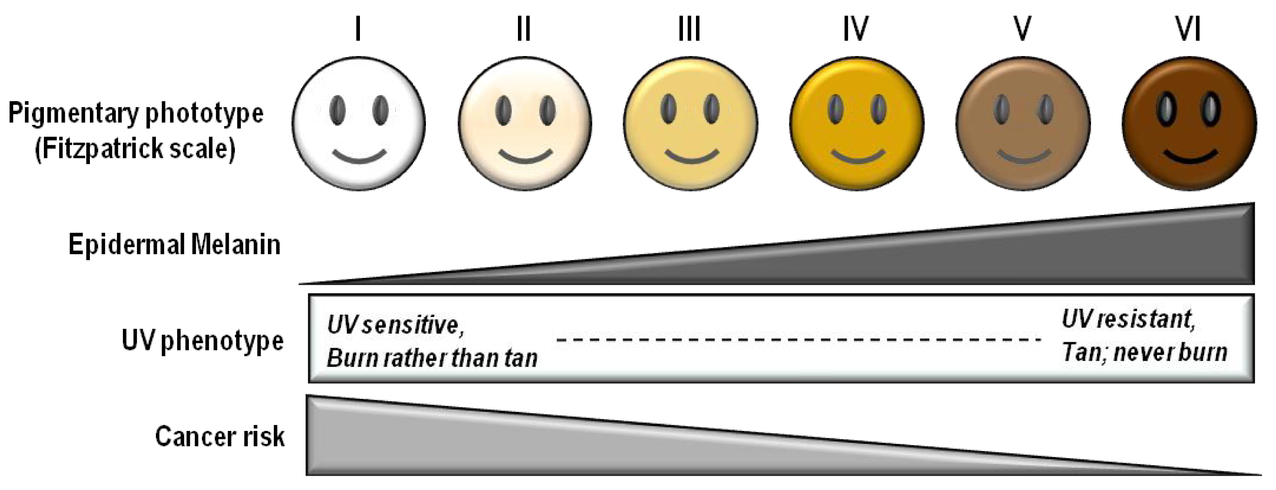Fitzpatrick scale on:
[Wikipedia]
[Google]
[Amazon]
 The Fitzpatrick scale (also Fitzpatrick skin typing test; or Fitzpatrick phototyping scale) is a numerical classification schema for
The Fitzpatrick scale (also Fitzpatrick skin typing test; or Fitzpatrick phototyping scale) is a numerical classification schema for
 The Fitzpatrick scale (also Fitzpatrick skin typing test; or Fitzpatrick phototyping scale) is a numerical classification schema for
The Fitzpatrick scale (also Fitzpatrick skin typing test; or Fitzpatrick phototyping scale) is a numerical classification schema for human skin color
Human skin color ranges from the Dark skin, darkest brown to the Light skin, lightest hues. Differences in Human skin, skin color among individuals is caused by variation in pigmentation, which is largely the result of genetics (inherited from o ...
. It was developed in 1975 by American dermatologist Thomas B. Fitzpatrick as a way to estimate the response of different types of skin to ultraviolet
Ultraviolet radiation, also known as simply UV, is electromagnetic radiation of wavelengths of 10–400 nanometers, shorter than that of visible light, but longer than X-rays. UV radiation is present in sunlight and constitutes about 10% of ...
(UV) light.Fitzpatrick, T. B. (1975). "Soleil et peau" un and skin ''Journal de Médecine Esthétique'' (in French) (2): 33–34 It was initially developed on the basis of skin color to measure the correct dose of UVA for PUVA therapy
PUVA (psoralen and UVA) is an ultraviolet light therapy treatment for skin diseases: vitiligo, eczema, psoriasis, graft-versus-host disease, mycosis fungoides, large plaque parapsoriasis, and cutaneous T-cell lymphoma, using the sensitizing effec ...
, and when the initial testing based only on hair and eye color resulted in too high UVA doses for some, it was altered to be based on the patient's reports of how their skin responds to the sun; it was also extended to a wider range of skin types.Pathak, M. A.; Jimbow, K.; Szabo, G.; Fitzpatrick, T. B. (1976). "Sunlight and melanin pigmentation". In Smith, K. C. (ed.): ''Photochemical and photobiological reviews'', Plenum Press, New York. pp. 211–39Fitzpatrick, T. B. (1986). "Ultraviolet-induced pigmentary changes: Benefits and hazards", ''Therapeutic Photomedicine'', Karger, vol. 15 of "Current Problems in Dermatology", pp. 25–38 The Fitzpatrick scale remains a recognized tool for dermatological research into human skin pigmentation.
The following table shows the six categories of the Fitzpatrick scale in relation to the 36 categories of the older von Luschan scale:
Emoji modifiers
The Fitzpatrick scale is also the basis of skin color inemoji
An emoji ( ; plural emoji or emojis; , ) is a pictogram, logogram, ideogram, or smiley embedded in text and used in electronic messages and web pages. The primary function of modern emoji is to fill in emotional cues otherwise missing from type ...
, with five modifiers according to the Fitzpatrick scale (types and merged).
Eurocentric bias
The Fitzpatrick scale has been criticized for its Eurocentric bias and insufficient representation of global skin color diversity. The scale originally was developed for classifying " white skin" in response tosolar radiation
Sunlight is the portion of the electromagnetic radiation which is emitted by the Sun (i.e. solar radiation) and received by the Earth, in particular the visible light perceptible to the human eye as well as invisible infrared (typically p ...
,Fitzpatrick, T. B. (1975). "Soleil et peau" un and skin ''Journal de Médecine Esthétique'' (in French) (2): 33–34 and initially included only four categories focused on white skin, with "brown" and "black" skin types (V and VI) added as an afterthought.
The scale's methodology, relying on self-reporting of skin color, sunburn
Sunburn is a form of radiation burn that affects living tissue, such as skin, that results from an overexposure to ultraviolet (UV) radiation, usually from the Sun. Common symptoms in humans and other animals include red or reddish skin tha ...
, and sun tanning
Sun tanning or tanning is the process whereby skin color is darkened or tanned. It is most often a result of exposure to ultraviolet (UV) radiation from sunlight or from artificial sources, such as a tanning lamp found in indoor tanning b ...
response, fails to capture the broad spectrum of skin reflectance. Studies demonstrate that European populations have the narrowest skin color variation, whereas groups categorized as 'brown' or 'black' exhibit a much wider range.
The efficacy of the Fitzpatrick scale even among white-skinned individuals has been argued to be questionable, since studies such as that on a Dutch student population have found it inadequate for categorizing, challenging its appropriateness for investigating the relationship between sunburn tendency and tanning ability.
The Fitzpatrick scale's Eurocentric orientation and its limitations in accurately representing global skin color diversity, along with similar biases in classifying other phenotypic traits, have been argued to require more inclusive and scientifically valid categorizations in dermatological and genetic research.
See also
* Monk Skin Tone Scale *von Luschan's chromatic scale
The term () is used in German surnames either as a nobiliary particle indicating a noble patrilineality, or as a simple preposition used by commoners that means or .
Nobility directories like the often abbreviate the noble term to ''v.'' I ...
* Skin reflectance
* Brown Paper Bag Test
References
{{Skin colors Dermatologic terminology Human skin color 1975 introductions Color scales